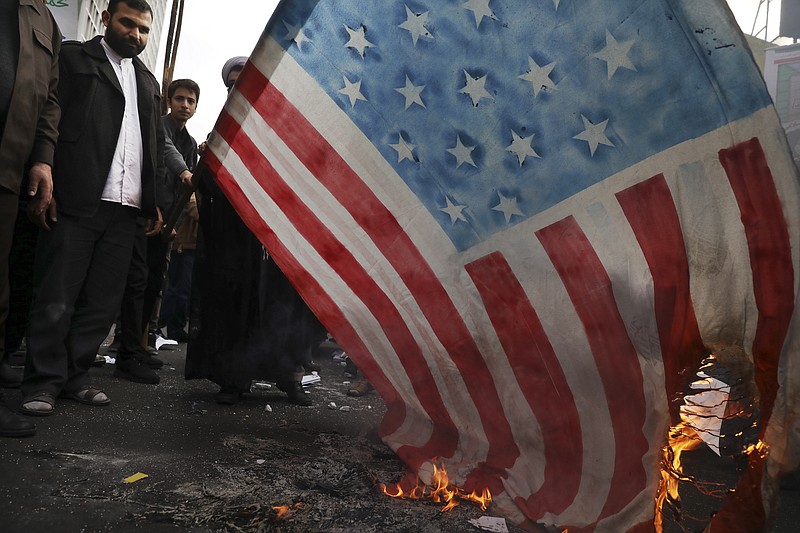TEHRAN, Iran (AP) - Iran on Monday broke further away from its collapsing 2015 nuclear deal with world powers by doubling the number of advanced centrifuges it operates, linking the decision to U.S. President Donald Trump's withdrawal from the agreement more than a year ago.
The announcement - which also included Iran saying it now has a prototype centrifuge that works 50 times faster than those allowed under the deal - came as demonstrators across the country marked the 40th anniversary of the 1979 U.S. Embassy takeover that started a 444-day hostage crisis.
By starting up these advanced centrifuges, Iran further cut into the one year that experts estimate Tehran would need to have enough material for building a nuclear weapon - if it chose to pursue one. Iran long has insisted its program is for peaceful purposes, though Western fears about its work led to the 2015 agreement that saw Tehran limit its enrichment of uranium in exchange for the lifting of economic sanctions.
Tehran has gone from producing some 1 pound of low-enriched uranium a day to 11 pounds, said Ali Akbar Salehi, the head of the Atomic Energy Organization of Iran. Iran now holds more than 1,102 pounds of low-enriched uranium, Salehi said. The deal had limited Iran to 661 pounds.
Visiting Iran's underground Natanz enrichment facility, Salehi dramatically pushed a button on a keyboard to start a chain of 30 IR-6 centrifuges as state television cameras filmed, increasing the number of working centrifuges to 60.
"With the grace of God, I start the gas injection," the U.S.-trained scientist said.
The deal once limited Iran to using only 5,060 first-generation IR-1 centrifuges to enrich uranium by rapidly spinning uranium hexafluoride gas. An IR-6 centrifuge can produce enriched uranium 10 times faster than an IR-1, Iranian officials said.
Salehi also announced scientists were working on a prototype he called the IR-9, which worked 50 times faster than the IR-1.
As of now, Iran is enriching uranium up to 4.5 percent, in violation of the accord's limit of 3.67 percent. Enriched uranium at the 3.67 percent level is enough for peaceful pursuits but is far below weapons-grade levels of 90 percent. At the 4.5 percent level, it is enough to help power Iran's Bushehr reactor, the country's only nuclear power plant. Prior to the atomic deal, Iran only reached up to 20 percent.
Iranian President Hassan Rouhani will announce further steps away from the accord sometime soon, government spokesman Ali Rabiei separately said Monday, suggesting Salehi's comments could be followed by additional violations of the nuclear deal. An announcement had been expected this week.
Iran has threatened in the past to push enrichment back up to 20 percent. That would worry nuclear nonproliferation experts because 20 percent is a short technical step away from reaching weapons-grade levels of 90 percent. It also has said it could ban inspectors from the United Nations' nuclear watchdog, the International Atomic Energy Agency.
The Vienna-based IAEA declined to comment on Iran's announcement. The IAEA previously said Iran planned to build two cascades, one with 164 IR-2M centrifuges and another with 164 IR-5 centrifuges. A cascade is a group of centrifuges working together to more quickly enrich uranium.
Iran broke through its stockpile and enrichment limitations to try to pressure Europe to offer it a new deal, more than a year since Trump unilaterally withdrew America from the accord. However, so far, European nations have been unable to offer Iran a way to help it sell its oil abroad as it faces strict U.S. sanctions.
Salehi again expressed Iran's ability to step back if a deal is made.
"If they return to their commitments, we also will go back to our commitments," he said.
Maja Kocijancic, a spokeswoman for the European Commission, urged Iran "to reverse such steps without delay and to refrain from any further measures that would undermine the nuclear deal."
The White House in a statement, noting the 40th anniversary of the hostage crisis, said the U.S. "will continue to impose crippling sanctions" until Iran changes its behavior. The U.S. also imposed new sanctions Monday on members of Supreme Leader Ayatollah Ali Khamenei's inner circle.

